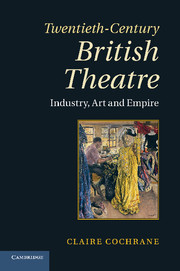Book contents
- Frontmatter
- Contents
- Acknowledgements
- Introduction
- Chapter 1 The topography of theatre in 1900
- Chapter 2 Structures of management
- Chapter 3 The profession of acting
- Chapter 4 The amateur phenomenon
- Chapter 5 The topography of theatre in 1950
- Chapter 6 The business of theatre
- Chapter 7 The changing demographic of performance
- Chapter 8 The topography of theatre in 2000
- Conclusion
- Notes
- Select Bibliography
- Index
Chapter 8 - The topography of theatre in 2000
Published online by Cambridge University Press: 05 November 2011
- Frontmatter
- Contents
- Acknowledgements
- Introduction
- Chapter 1 The topography of theatre in 1900
- Chapter 2 Structures of management
- Chapter 3 The profession of acting
- Chapter 4 The amateur phenomenon
- Chapter 5 The topography of theatre in 1950
- Chapter 6 The business of theatre
- Chapter 7 The changing demographic of performance
- Chapter 8 The topography of theatre in 2000
- Conclusion
- Notes
- Select Bibliography
- Index
Summary
This attempt to construct a topography of theatre in 2000 takes as its starting point the thoughts on space expressed by the geographer Nigel Thrift:
As with terms like ‘society’ and ‘nature’, space is not a commonsense external background to human and social action. Rather, it is the outcome of a series of highly problematic temporary settlements that divide and connect things up into different kinds of collectives which are slowly provided with the means which render them durable and sustainable.
Coming after the socio-political theatrical experiments that were associated with the 1970s, the term ‘collective’ has a very particular resonance for theatre scholars, and, indeed, one aspect of the spatial-temporal outcomes discernible in 2000 is the means by which old-style collectives had evolved into something more sustainable. However, to delineate the features of the landscape as whole in 2000 it is now necessary to think of collectivity and connectivity in much broader terms.
For 1950 I used the image of the intersection of over lapping circles to show the spatial relationships formed by commercial, metropolitan theatre, theatre strategically promoted through the emerging state funding body, and a diffuse and mainly commercial regional theatre sector. For 2000 the most appropriate image might be theatre as an organism formed from interlocking cells or clusters of activity, each corresponding to a different embodied constituency of interest whether composed of audiences or participants. I would argue that this is certainly the best way to think about regional theatre, although the way in which power was exercised spatially, both materially and in the abstract from the metropolis, showed that the geo-economic model of the core–periphery relationship was still highly relevant. But there was no doubt despite the complexity of economic relationships across sectors, that public funding for the arts had physically transformed the built landscape, and moreover, enabled other models of theatre ‘settlement’ which were strategically connected.
- Type
- Chapter
- Information
- Twentieth-Century British TheatreIndustry, Art and Empire, pp. 239 - 270Publisher: Cambridge University PressPrint publication year: 2011



